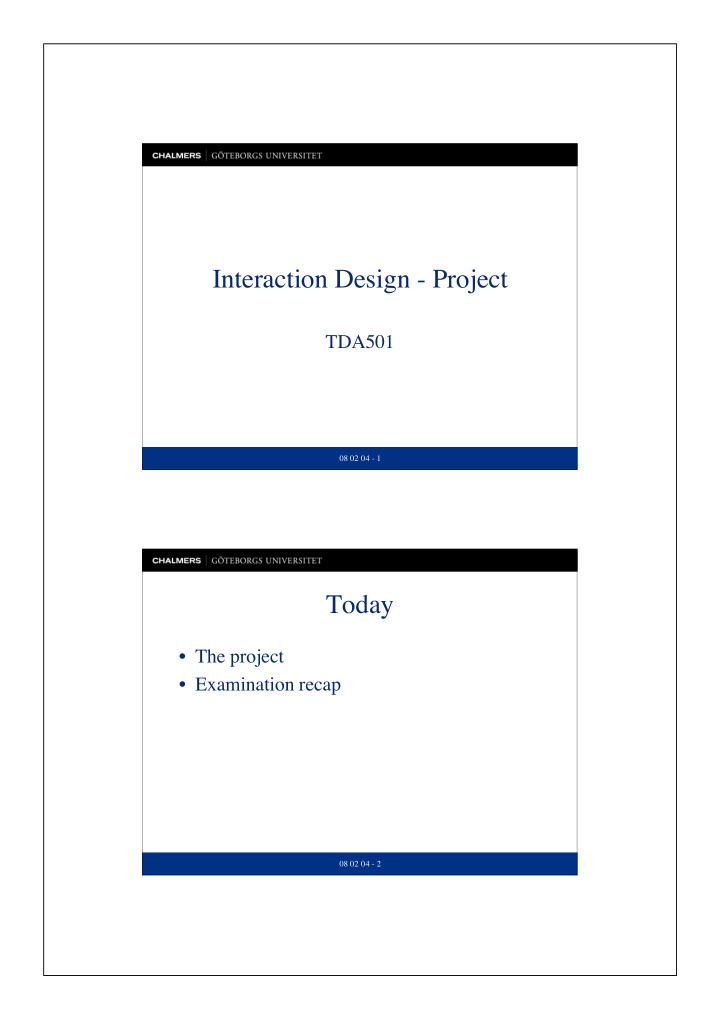



Interaction Design - Project TDA501 08 02 04 - 1 Today • The project • Examination recap 08 02 04 - 2
The Course • A few lectures • Some design exercises • A few of literature seminars • A large group project • An individual home assignment • Check home page – http://www.cs.chalmers.se/idc/ituniv/kurser/08/idproj/ 08 02 04 - 3 Overview 4 Aesthetics in Interaction Design 5 6 7 8 Project Work 9 10 11 12 Easter Holiday 13 Re-examination week 14 15 16 Project Work 17 18 19 20 Exhibition 21 Report 22 Individual assignment 08 02 04 - 4
Projects • Theme: – Games and playful interaction design – (with an awareness of aesthetics) • Requirements: – Projects should involve information technology as a key component – Projects should have a clear relation to the course theme • Groups: formed by you 08 02 04 - 5 08 02 04 - 6
08 02 04 - 7 Extended memory 08 02 04 - 8
08 02 04 - 9 08 02 04 - 10
08 02 04 - 11 Projects • Theme: – Games and playful interaction design – (with an awareness of aesthetics) • Requirements: – Projects should involve information technology as a key component – Projects should have a clear relation to the course theme • Almost anything but not administrative systems for instance 08 02 04 - 12
Process • This week form groups and start generating ideas • Wednesday February 13 – Hand in 3 proposals • Thursday February 14 – Present proposals to class • Week 8 – Supervision concerning ideas 08 02 04 - 13 Process • Monday Februry 25 – Present proposal to class and external judges • February 28 – Hand in initial design document – Details presented later • Week 10-11 peer review of design documents 08 02 04 - 14
Process • April 3 – Low-fi prototype demo – More details will be given • April 7 – Hand in written feedback on low fi prototypes – More details will be given • April 10 – Hand in revised design document 08 02 04 - 15 Process • May 8 – Project web site on line • Week 20 – Exhibition • May 22 – Hand in project report • May 30 – Hand in individual assignment 08 02 04 - 16
Documents • 3 proposals – Rather brief – Concept description – Description of the context of use – Possible users and, last but not least – Why this project is interesting, i.e., what do you want to explore by implementing it? 08 02 04 - 17 Initial Design Document • More details will be given later! – Description of your idea or concept, motivate your choice and give a short background description. – Some sort of picture or sketch of the concept. – Description of how you have planned to implement and how you plan to realise your idea. – If your project is dependent on a certain technology, then describe this. – Suggestion of criteria for how you can validate how well you have succeeded with your project. – A time-plan for how you imagine to realise the different parts of the project. 08 02 04 - 18
Peer Review • The groups review each others initial design documents • Revised version produced • Details to appear 08 02 04 - 19 Report • 2 parts – Web – Traditional written report – Both important (35-65 could still change) • Web – Presentation and downloads • Paper – All details 08 02 04 - 20
Exhibition • For the public • Open several days • Likely location Navet • Working prototype • Information poster(s) 08 02 04 - 21 Exhibition PR • Web site • Written invitation • Press releases • Voluntary work – Consider interest – Fun – Useful for portfolio/CV 08 02 04 - 22
Supervision • Each group will get a supervisor • Supervision concerning technology will exist • Similar to Ubicomp course 08 02 04 - 23 File area • Each group will get a shared file area on a Chalmers server • Store project material • CVS • Web site • Technically as web sites in Ubicomp • Available later this week (hopefully) 08 02 04 - 24
Examination • To pass the course you should – Actively participate in all parts of the course – Do the project • Details will be explained in 2 weeks – Write an approved project report – Write 2 individual home assignments • Grading – Chalmers: Fail, 3, 4, 5 – GU: Pass and Pass with distinction (G, VG) 08 02 04 - 25 Examination continued • The course grade is determined by upon the following weighed average of the grades on the assignments: – 30% Report – 20% Demonstrator – 10% Exhibitions – 10% Oral presentations of concepts – 10% Assessed individual contribution – 20% Individual assignment 08 02 04 - 26
Course Evaluation • Same as in other courses • Volunteers? – ID, Chalmers – MDI/ID – ISD – GU 08 02 04 - 27 Register • Chalmers students – Student portal – Interaction design • Student centre maskingränd • kristina.nystrom@chalmers.se – MDI/ID • IT-university • studieadministration@ituniv.se • GU students – Ida Holmgren – studievagledare@cs.chalmers.se 08 02 04 - 28
Recommend
More recommend